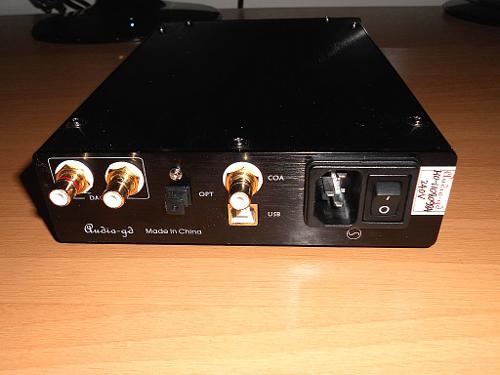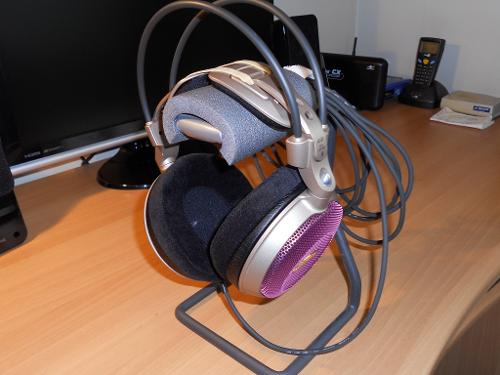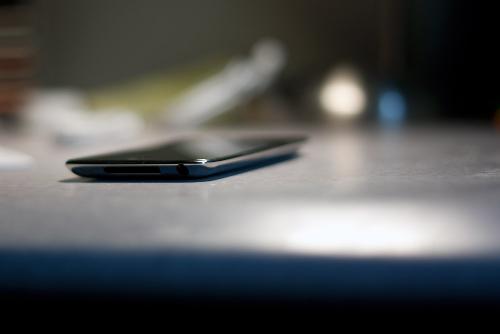The Sennheiser HD600 is an open dynamic circumaural head-phone which Sennheiser market for audiophiles, and also state as ideal for studio monitoring.

Pre-amble (about me at time of writing)
I'm a 44 year old music lover. I don't say audiophile - just love my music. Over the last couple of years, I have slowly changed from cheaper listening set-ups to my current entry/mid-fi set-up. I vary my listening from portable (i-devices + amp) to my desk-top's set-up (PC > coax > NFB-12 > HP). My main headphones at the time of writing are the Sennheiser HD600s, a modded set of Alessandro MS1i, and a set of B2 iems. I previously owned Beyer DT880, Shure SRH840 and 940 + various other IEMs. I have auditioned quite a few entry and mid-tier cans, but have yet to hear any flagships (at current time of writing this review). I have very eclectic music tastes listening to a variety from classical and opera to grunge and hard-rock. I listen to a lot of blues, jazz, folk music, classic rock, and alternative rock. I am particularly fond of female vocals. I tend toward cans that are relatively neutral/balanced - with a slight emphasis on the mid-range. I prefer a little warmth in the overall signature. I am neither a bass or treble head. Current amps = NFB12, GoVibe PortaTube, Fiio E11. Previous desktop set-up was a Fiio E7/E9 combo.
Packaging and Accessories
I purchased my HD600s from another Head-fi member. They come with a very solid and well padded case, and a 3.5-6.3mm adapter.
Technical Specifications
From the Sennheiser website :
Nominal impedance = 300Ω
Contact pressure = ca. 2,5 N
Weight w/o cable = 260 g
Jack plug = 3,5/6,3 mm stereo
Transducer = principle dynamic, open
Ear coupling = circumaural
Cable length = 3 m
Frequency response (headphones) = 12 - 39000 Hz
Sound pressure level (SPL) = 97 dB at 1 mW
THD, total harmonic distortion = 0,1 %
Frequency Response Graph
(From HeadRoom)

Build / Comfort / Isolation
The HD600's build is solid - but not 'bullet proof'. They are very light-weight (plastic headband - with a carbon fibre inner band) - but they are well put together. If I had one criticism, it would be that the headband is not as strong as I expected. When I got mine, I found them a little 'clampy' - so thinking the carbon fibre inner would be strong enough, I tried to stretch them to alleviate the clamp. Big no-no. Snap! One broken headband, and me almost shedding 'manly' tears. Admittedly, I stretched more than I should have - but it was because I expected the carbon fibre to allow the plastic outer to bend. Anyway - you have been warned. I'll tell you how I fixed them down the page shortly. The shell is plastic (very light) with some plastic moldings - the outer shell has a marbled look - that I think actually looks quite classy.


The headband padding is actually very soft and extremely comfortable. The ear pads are a soft velour which has quite deep cups, and are also very comfortable. Note - after a while you get used to the tight clamp - and I've found I could wear them for hours. They would be the second most comfortable headphones I've owned - just behind the DT880s.


These are an open can - so there is no isolation in or out. They are not as bad as a Grado - but they are open.
The huge benefit with these cans is that they are completely modular - you are able to break them down fully, and all parts are replaceable - even the drivers. So after my "mishap" - I got in touch with Sennheiser, and they had a replacement headband on it's way to me. It was a very simple operation to dismantle the headphone and swap the parts out.

The cable is also replaceable, and you can go after market if you wish. Personally I find the stock cable to be very sturdy (advertised as OFC copper and kevlar reinforced) - and it doesn't seem to be prone to cable noise or tangling.
Listening Set-up
My main set-up with the HD600 is PC > Coax > NFB-12 >HD600. For a transportable rig, I use iPhone4 > PortaTube > HD600.
Sound Quality
These are very simply "keepers". They are the most natural sounding headphone I have used or auditioned to date. They are very well balanced across the spectrum - with a slightly elevated mid-bass and lower mids. Overall I would call the sound slightly warm without being dark. I used to play guitar, and have spent time in my youth listening to live orchestra and solo violin - and I found the HD600 to be quite realistic. A quick summary of the main sound quality headings:
Detail - While not as detailed as the DT880, I found the detail on these still quit high. They do tend to be slightly laid back, and can get slightly congested with very fast music. The clarity is very good. I find them articulate and refined.
Sound-stage - Similar to the DT880 in overall size. Depth and width ifs quite good, and instrument separation (particularly for classical) is quite good.
Highs - These surprised me. They are nowhere near as etched as the DT880, but I don't find them veiled at all. For me the highs are quite natural - no trace of sibilance or harshness, with still good detail. Highs are not the focus, but they are still presented beautifully.
Mids - IMO this is where the HD600 really shines. Acoustic guitar (any stringed instrument really), piano, and female vocals especially are wonderful on the HD600. I recently bought Alison Krauss and Union Station's album Paper Airplane. The combination of Alison's vocals and the bluegrass flavour of the music is simply divine.
Bass - on the NFB-12, the bass is well defined and punchy - with good impact. it just doesn't reach low into the sub-bass like the DT880. But it doesn't need to - because once again the bass is beautifully balanced with the rest of the frequencies.
Power Requirements
The HD600 has 300 ohm nominal impedance - but what surprised me is how easy these are to actually drive. They do sound wonderful out of the NFB-12 and also my PortaTube - which both have plenty left on the pot. But I can also play these easily on the little Fiio E11, and even out of the headphone out of my iPhone4 (admittedly on about 80% volume). On the iPhone4 unamped, the bass becomes quite boomy and muddled - so it's obviously not being driven properly - but these don't require huge power. They do seem to scale well - the difference between E11, my E7/E9 (when I owned it) and now the NFB-12 is noticeable - with extra body and definition from the NFB-12. I'm looking forward to trying these with a Schitt Valhalla sometime next year.
Summary / Conclusion
The HD600 has become my favourite headphone for simply listening to music. They are well built, comfortable, and sound simply phenomenal. Their tonal balance and the naturalness of their sound is the best I've personally heard so far. While I wouldn't recommend them for critical listening (the DT880 is better for the extra detail and extension it brings), for non-critical listening enjoyment - there are few better IMO.

Pre-amble (about me at time of writing)
I'm a 44 year old music lover. I don't say audiophile - just love my music. Over the last couple of years, I have slowly changed from cheaper listening set-ups to my current entry/mid-fi set-up. I vary my listening from portable (i-devices + amp) to my desk-top's set-up (PC > coax > NFB-12 > HP). My main headphones at the time of writing are the Sennheiser HD600s, a modded set of Alessandro MS1i, and a set of B2 iems. I previously owned Beyer DT880, Shure SRH840 and 940 + various other IEMs. I have auditioned quite a few entry and mid-tier cans, but have yet to hear any flagships (at current time of writing this review). I have very eclectic music tastes listening to a variety from classical and opera to grunge and hard-rock. I listen to a lot of blues, jazz, folk music, classic rock, and alternative rock. I am particularly fond of female vocals. I tend toward cans that are relatively neutral/balanced - with a slight emphasis on the mid-range. I prefer a little warmth in the overall signature. I am neither a bass or treble head. Current amps = NFB12, GoVibe PortaTube, Fiio E11. Previous desktop set-up was a Fiio E7/E9 combo.
Packaging and Accessories
I purchased my HD600s from another Head-fi member. They come with a very solid and well padded case, and a 3.5-6.3mm adapter.
Technical Specifications
From the Sennheiser website :
Nominal impedance = 300Ω
Contact pressure = ca. 2,5 N
Weight w/o cable = 260 g
Jack plug = 3,5/6,3 mm stereo
Transducer = principle dynamic, open
Ear coupling = circumaural
Cable length = 3 m
Frequency response (headphones) = 12 - 39000 Hz
Sound pressure level (SPL) = 97 dB at 1 mW
THD, total harmonic distortion = 0,1 %
Frequency Response Graph
(From HeadRoom)

Build / Comfort / Isolation
The HD600's build is solid - but not 'bullet proof'. They are very light-weight (plastic headband - with a carbon fibre inner band) - but they are well put together. If I had one criticism, it would be that the headband is not as strong as I expected. When I got mine, I found them a little 'clampy' - so thinking the carbon fibre inner would be strong enough, I tried to stretch them to alleviate the clamp. Big no-no. Snap! One broken headband, and me almost shedding 'manly' tears. Admittedly, I stretched more than I should have - but it was because I expected the carbon fibre to allow the plastic outer to bend. Anyway - you have been warned. I'll tell you how I fixed them down the page shortly. The shell is plastic (very light) with some plastic moldings - the outer shell has a marbled look - that I think actually looks quite classy.


The headband padding is actually very soft and extremely comfortable. The ear pads are a soft velour which has quite deep cups, and are also very comfortable. Note - after a while you get used to the tight clamp - and I've found I could wear them for hours. They would be the second most comfortable headphones I've owned - just behind the DT880s.


These are an open can - so there is no isolation in or out. They are not as bad as a Grado - but they are open.
The huge benefit with these cans is that they are completely modular - you are able to break them down fully, and all parts are replaceable - even the drivers. So after my "mishap" - I got in touch with Sennheiser, and they had a replacement headband on it's way to me. It was a very simple operation to dismantle the headphone and swap the parts out.

The cable is also replaceable, and you can go after market if you wish. Personally I find the stock cable to be very sturdy (advertised as OFC copper and kevlar reinforced) - and it doesn't seem to be prone to cable noise or tangling.
Listening Set-up
My main set-up with the HD600 is PC > Coax > NFB-12 >HD600. For a transportable rig, I use iPhone4 > PortaTube > HD600.
Sound Quality
These are very simply "keepers". They are the most natural sounding headphone I have used or auditioned to date. They are very well balanced across the spectrum - with a slightly elevated mid-bass and lower mids. Overall I would call the sound slightly warm without being dark. I used to play guitar, and have spent time in my youth listening to live orchestra and solo violin - and I found the HD600 to be quite realistic. A quick summary of the main sound quality headings:
Detail - While not as detailed as the DT880, I found the detail on these still quit high. They do tend to be slightly laid back, and can get slightly congested with very fast music. The clarity is very good. I find them articulate and refined.
Sound-stage - Similar to the DT880 in overall size. Depth and width ifs quite good, and instrument separation (particularly for classical) is quite good.
Highs - These surprised me. They are nowhere near as etched as the DT880, but I don't find them veiled at all. For me the highs are quite natural - no trace of sibilance or harshness, with still good detail. Highs are not the focus, but they are still presented beautifully.
Mids - IMO this is where the HD600 really shines. Acoustic guitar (any stringed instrument really), piano, and female vocals especially are wonderful on the HD600. I recently bought Alison Krauss and Union Station's album Paper Airplane. The combination of Alison's vocals and the bluegrass flavour of the music is simply divine.
Bass - on the NFB-12, the bass is well defined and punchy - with good impact. it just doesn't reach low into the sub-bass like the DT880. But it doesn't need to - because once again the bass is beautifully balanced with the rest of the frequencies.
Power Requirements
The HD600 has 300 ohm nominal impedance - but what surprised me is how easy these are to actually drive. They do sound wonderful out of the NFB-12 and also my PortaTube - which both have plenty left on the pot. But I can also play these easily on the little Fiio E11, and even out of the headphone out of my iPhone4 (admittedly on about 80% volume). On the iPhone4 unamped, the bass becomes quite boomy and muddled - so it's obviously not being driven properly - but these don't require huge power. They do seem to scale well - the difference between E11, my E7/E9 (when I owned it) and now the NFB-12 is noticeable - with extra body and definition from the NFB-12. I'm looking forward to trying these with a Schitt Valhalla sometime next year.
Summary / Conclusion
The HD600 has become my favourite headphone for simply listening to music. They are well built, comfortable, and sound simply phenomenal. Their tonal balance and the naturalness of their sound is the best I've personally heard so far. While I wouldn't recommend them for critical listening (the DT880 is better for the extra detail and extension it brings), for non-critical listening enjoyment - there are few better IMO.















































 . I haven't listened to a lot of music with the HDs yet bu plan to do that this weekend. Of course, right from the bat, the soundstage and bass of the Senns is palpable but I guess that at this point I'm so used to the "brightness" of the 940s that I kind of want to expect that level of clarity on every can! Powering them with the Icon HDP.
. I haven't listened to a lot of music with the HDs yet bu plan to do that this weekend. Of course, right from the bat, the soundstage and bass of the Senns is palpable but I guess that at this point I'm so used to the "brightness" of the 940s that I kind of want to expect that level of clarity on every can! Powering them with the Icon HDP.















































@reilhead - well if you mean for travelling - ie in quiet hotel room at night, then yes the HD600 can be driven adequately with an Xf IMO. Playing some Dire Straits on mine at the moment, and comfortable listening level is around 70/120 on low gain - so plenty of head room left. My NFB-12 or LD MKIV is a little smoother, and more organic - but they sound way better than "just OK" with the X5.
If you're talking about on-the-go as in anywhere there is external noise, then the HD600 isn't your headphone. they're not exactly portable